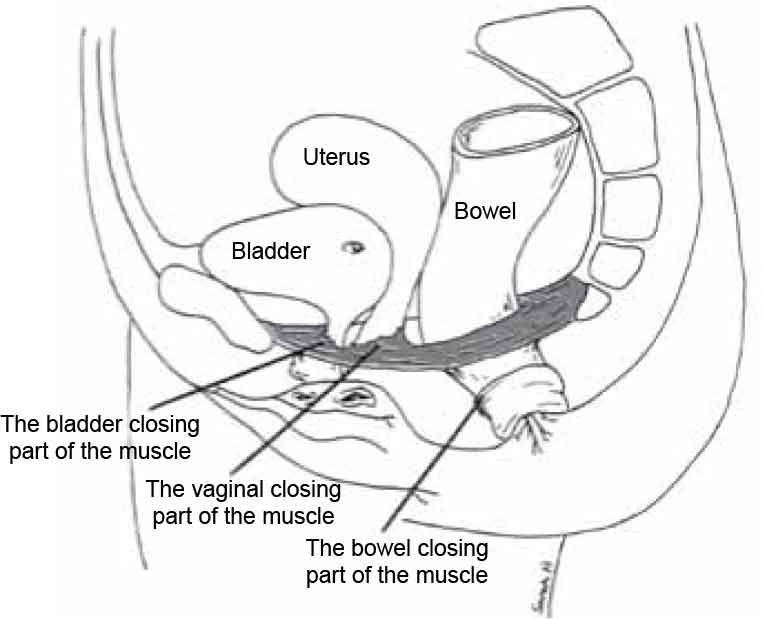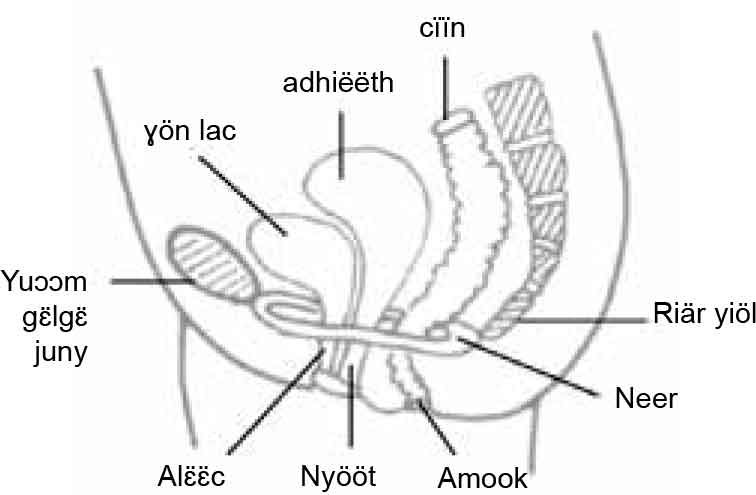|
Women who have even just one baby are nearly three times more likely to leak urine and wet themselves, than women who have not had a baby. The more babies you have, the more chance there is that you will leak urine and wet yourself. |
Na cɔk ya tiŋ cë dhiëth mɛnh tök, tɛ̈ thööŋ yïn yen ke tiŋ këc kaŋ dhiëth, ka lëu bë rot ya läc. Na cë tik dhiëth mïth juëc, ka acuek keen aŋuum aa bë lär apɛi ku ye rot läc apɛy. |
Why do you leak urine after having a baby?When the baby moves down through the birth canal, it stretches the nerves and muscles that keep the bladder shut. These are called the pelvic floor muscles, and they can sometimes be left weak, and not able to keep the bladder from leak ing. Leaking happens mostly when you cough, sneeze, lift or do exercise. It is rare for the bladder to be hurt during birth, but the muscles and nerves often are, and you need to do pelvic floor muscle training to help the muscles get strong again. |
Yeŋö yïn rot läc tɛ̈ cïn dhiët meth?Na yök meth jɛ̈l yiëëc bë tëëk wath yic, ka acuek aŋuum aa ke yiic miit bë meth tëëk. Acuek aŋuum kä aa lëu bïk cï ben dhuk nyiɛn den – aa lëu bïk rëër ke cë lär ku yekä tik cɔl a lɛ̈c rot. Tik ee rot läc tɛ̈ ɣɔɔl, tïïm, jöt, dɔl yen wälä tɛ̈ tuuk yen në tuk kɔc rïïl gup. A ce rot lac looi bë alɛ̈ɛ̈c yic rɛɛt tɛ̈ dhiët tik ku acuek aŋuum ku räl aa lac cak – keya, ka yïn a dhil acuek aŋuum ya duääny rin bïk riɛl. |
Will this leaking go away by itself?If you have any leaking, it will not go away if you just ignore it. Leaking is likely to stop if you train your pelvic floor muscles, to help get their strength back. If you don’t get pelvic floor muscle strength back after each baby you have, you may start wetting yourself, as the pelvic floor muscles get weaker with age. |
Lɛ̈c ɣɛn rot läc kë n bë jäl rot?Na ye rot läc, ka cë bë jäl rot tɛ̈ cïn ye ŋic muk nhom. Lɛ̈c rot a lëu bë kɔ̈ɔ̈c tɛ̈ yïn acuek kuun aŋuum ŋiɛc duääny, rin bë riɛl deen thɛɛr dhuk. Na këc riɛl deen dhuk mën tɛ̈n dhiëët manh tueŋ, ka lɛ̈c rot a lëu bë rot gɔl, rin ye riɛl acuek aŋuum la ka jäl tɛ̈ dhiɔɔp tik. |
How does my bladder work?The bladder is a hollow muscle pump. It fills slowly from the kidneys, and can hold at least one and a half to two cups of urine (300 to 400mls). The bladder outlet tube is kept closed by the pelvic floor muscles. When the bladder is full and you decide to pass urine, the pelvic floor muscles relax when you sit on the toilet, and the bladder squeezes the urine out. Then the same “fill and empty” cycle begins again. |
Al änydië ye luui kadä?Alɛ̈ɛ̈c ee acueŋ ɣɔ̈r yic wën käŋ piëk aɣeer. Yen a thiäŋ amääth lɛc wët bei rok yiic, ku a lëu bë bïny ɣet bïïny ka rou (300mla ɣet 400mla) ë lɛc muk. Dhël ye lɛc tëëk thïn ee rëër ka cï acuek aŋuum thiöök thok. Na cë alɛ̈ɛ̈c thiäŋ ku wïc ba la laac, ka acuek aŋuum aa dɛ̈k ke yiic tɛ̈ cïn nyuc ba laac, ku alɛ̈ɛ̈c lɛc piëk aɣeer. Ku ben thiäŋ ku bɛn laac. |
What do my pelvic floor muscles do?See the picture of the pelvic floor. The pelvic floor muscles do a number of things, they:
|
Yeŋö ye ac uek kiëë n aŋ uum looi?Tïŋ cuura acuek aŋuum. Acuek aŋuum aa kä juääc looi, kä yekä looi aa kïk:
|
 |
 |
What happens if my pelvic floor muscles are weak after having my baby?
|
Yeŋö bë rot luöi ɣɛɛ n tɛ ̈ le ac uek kiëë n aŋ uum lär rin cï ɣɛn dhiët mïth?
|
What can I do to stop these things from happening?
|
Yeŋö ba looi ba käkä cɔl a kääc?
|
How can I care for my weak pelvic floor muscles?The birth of a baby might have stretched your pelvic floor muscles. Any ‘pushing down’ actions in the first weeks after the baby’s birth might stretch the pelvic floor muscles again. You can help to protect your pelvic floor muscles by not pushing down on your pelvic floor. Here are a few ideas to help you.
|
Ba Ac Uek Kiëë N Aŋ Uum Cë Lär Muk Nhïïm Kadä?Tɛkdä ka dhiënh meth a cë acuek kuun aŋuum cɔl a lär. Na leŋ kë bɛn cɔl wiik puɔc meth dhiëët thïn yiic ka acuek aŋuum aa lëu bïk bɛn lär apɛy. A lëu ba acuek kuun aŋuum cɔl dhuk nyin deen thɛɛr tɛ̈ pëën yïn cölcöl. Loi käkä ba acuek kuun aŋuum cɔl a dhuk nyin deen thɛɛr.
|
Where are my pelvic floor muscles?The first thing to do is to find out which muscles you need to train.
If you don’t feel a distinct “squeeze and lift” of your pelvic floor muscles, or if you can’t stop your stream of urine as talked about in Point 3, ask for help from your doctor, physiotherapist, or continence nurse advisor. They will help you to get your pelvic floor muscles working right. Even women with very weak pelvic floor muscles can gain from pelvic floor muscle training. |
Acuek kiëë n aŋ uum tɔ̈ukä tɛ ̈no?Kë ba kaŋ looi ee ba acuek aŋuum ka ŋic tɛ̈ rëër kek thïn ku jɔl duɛ̈ɛ̈ny gɔl.
Na cïn tɛ̈ ye yök, wälä cïn tɛ̈ ye yïn lɛc teem kɔ̈ɔ̈th tɛ̈ mën wën cï ye lueel abaŋ 3 yic, ka yï la tɛ̈n akiɛ̈m du, raan duun yï duääny wälä akuɔnyakïm ë thiu thar. Keek kɔɔc kä aa lëu bïk yï kony ba acuek kuun aŋuum cɔ̈k piny. Gut diäär cï acuek aŋuum nyïn lär aa lëu bïk tɛ̈thi yök tɛ̈ duɛ̈ɛ̈ny kek acuek keen aŋum. |
How do I do pelvic floor muscle training?Now that you can feel the muscles working—
While doing pelvic floor muscle training—
|
Ba räl ac uek kiëë n aŋ uum duää ny kadä?Mën cïn acuek kuun aŋuum jal ŋic tɛ̈ ye kek luui thïn—
Ka yï dhuɛ̈ɛ̈ny acuek kuun aŋuum—
|
Do your pelvic floor muscle training wellFewer good squeezes are better than a lot of half hearted ones! If you are not sure that you are doing the squeezes right ask for help from your doctor, physiotherapist, or continence nurse advisor. |
Ye ac uek kuun aŋ uum ŋiɛc duää nyNa ye acuek aŋuum ŋiɛc rot ku jɔt keek arak lik yiic ka cë cït tɛ̈ yïn ye looi arak juääc ku a cï ye ŋiɛc looi! Na kuc lɔn yïn acuek aŋuum ŋiɛc rot ku jɔt keek, ka yï cɔl rot a kony akiɛ̈m du, raan duun yï duääny wälä akuɔnyakïm ë thiu thar. |
Make the training part of your daily lifeOnce you have learnt how to do pelvic floor muscle squeezes, you should do them often. Every day is best, giving each set of squeezes your full focus. Make a regular time to do your pelvic floor muscle squeezes. This might be when you:
It’s a good idea to get into the lifelong habit of doing one set of pelvic floor muscle exercises every time you go to the toilet, after passing urine or opening your bowels. |
Loi duɛ̈ɛ̈ny kën bë ya kë duun ye looi abakNa ca rut ku jön acuek aŋuum ŋic, ka path ba ya looi abak. Na ye looi abak ka path apɛy, ku ye yï puöu tääu thïn tɛ̈ looi yïn yeen. Lɔc kaam bïn acuek aŋuum ya duääny. Tɛkdä ka lëu ba ya looi kuat:
Apath ba duääny tök ŋiëëc ku ye looi kuat tɛ̈ le yïn ɣön la roor wälä tɛ̈ lɛɛc yïn. |
What if things don’t improve?Pelvic floor muscle damage may take up to six months to get better. If things are not getting better after six months, speak to your doctor, physiotherapist or continence nurse advisor. |
Ŋö bë yië ndä tɛ̈ cïn yen tɛ̈thii n yök?Acuek aŋuum cë cak aa lëu bïk wiik ka dhëtem looi ke këc dɛm. Na cïn tɛ̈thiin ca yök wiik ka dhëtem yicc, ka yï la tɛ̈n akiɛ̈m du, raan duun yï duääny wälä akuɔnyakïm ë thiu thar. |
Also ask your doctor for help if you notice any of the following:
|
Aya, cɔl rot ak ony ak ïm tɛ̈ leŋ yen kë cë rot luöi yïïn ye käkä yiic:
|
Seek helpQualified nurses are available if you call the National Continence Helpline on 1800 33 00 66* (Monday to Friday, between 8.00am to 8.00pm Australian Eastern Standard Time) for free:
If you have difficulty speaking or understanding English you can access the Helpline through the free Telephone Interpreter Service on 13 14 50. The phone will be answered in English, so please name the language you speak and wait on the phone. You will be connected to an interpreter who speaks your language. Tell the interpreter you wish to call the National Continence Helpline on 1800 33 00 66. Wait on the phone to be connected and the interpreter will assist you to speak with a continence nurse advisor. All calls are confidential. * Calls from mobile telephones are charged at applicable rates. |
Wïc kuɔɔnyMathaat akïm cï piöc aabï tɔ̈ na yï ayup telepun Kuɔɔny Baai käk thiu thar ee nïmra kënëic tök, bɛ̈t, gueu, diäk, diäk, gueu, dhetem, dhetem*/ 1800 33 00 66* (aköl Tök agut aköl Dhiëc ee Läätic (Monday- Friday) kaam thaa bɛ̈t nhiäk-duur (8am) ku thaa bɛ̈t thëëi (8pm) ee thaa kɔc Australia ciëŋ Ciëën) aye gäm kɔc abɛc:
Na yïn acie ŋiëc jam thoŋ English apiɛth ka yïn alëu ba telpun luɔi ye kɔc Kuɔny wɛ̈r thokic yuɔ̈p. Cɔl nïmra kënë tök diäk, tök, ŋuan, dhiëc/13 14 50. Tueŋic, abï raan kɔŋ dhuk nhom ee thoŋ English, luel thoŋduɔ̈n ee yïn jam ku tiɛ̈ɛ̈t ee telepunic. Yïn abï tuɔ̈ɔ̈m thok kek raan kɔc waar thook/duwër jam thuɔŋdu, ku jal kek lɛ̈k wɛ̈tduɔ̈n wïc ee yïn kɔc Baai Kuɔɔny Käk thiu thar yuɔ̈p ee nïmra kënëic tök, bɛ̈t, gueu, diäk, diäk, gueu, dhetem, dhetem/ 1800 33 00 66. Tiɛ̈ɛ̈t ee telepunic ku bï yï gam ku duwër abï kony ba jam kek mathaat akïm kɔc lɛ̈k. Telepun duwër aye kɔc yup thïn abɛc/majan ee rin cïn en wëu ye wïc tënë yïn. Kek wël ëbɛ̈n aye thiaan yiic. * Yup mobaalic ee wëu cam tëcït cɔ̈t baai ëtɛ̈n. |
One In Three Women Who Ever Had A Baby Wet Themselves in Dinka
Tök Diäkic Alɔŋ Diäär Cï Kɔŋ Dhiëth Meth Aröt Läc
Browse and download our factsheets in Dinka
Last Updated: Fri 30, Jul 2021
Last Reviewed: Tue 17, Mar 2020

